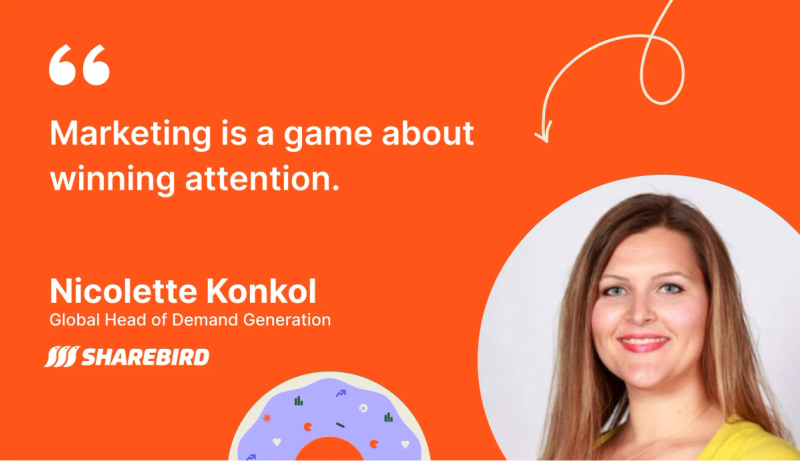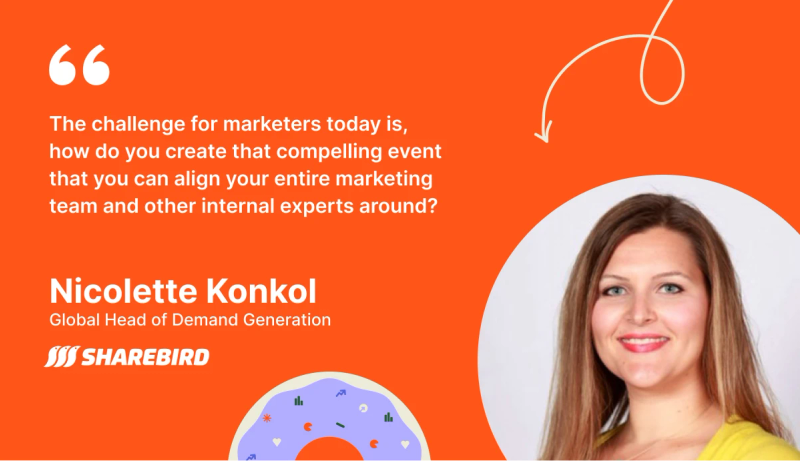Why Being Basic Isn't a Bad Thing and How To Get Employees To Care About Campaigns

Table of Contents
Maximize Your Marketing ROI
Join 10,000 other marketers already getting the best tips on running engaging events that boost pipeline and create raving fans.
With the year in full swing and a constant focus on what's trending, sometimes it's refreshing to be reminded of the importance of going back to the fundamental marketing knowledge we all have. Keep it simple, and all that!
For our last Donuts & Demand, Goldcast's Head of Marketing and Growth, Kelly Cheng, talked to Nicolette Konkol, Global Head of Demand Generation at Morningstar, about why no campaign can succeed without revisiting the basic questions marketers learn early on.
Nicolette also shared a BTS look at a previous campaign she worked on, in which she successfully motivated employees to amplify a message (a marketer's dream!), as well as how she's thinking about attribution in her current role.
Let's dive in to find out:
- Getting back to basics
- Then it's time to experiment away
- Case study: How to galvanize your employee base around a campaign
- How do you motivate employees to post?
- Pipeline and revenue contribution aren't the end-all
- Watch the full replay for even more marketing insights
PS: You can view the entire event session on-demand, too!
Getting back to basics
It's easy to get swept up in the latest viral sensations, but make sure your efforts are always rooted in those important, fundamental questions marketers need answered before they can do anything else. These are questions like: Who is my target audience? Where do they hang out? Why should they care about this?
If you can't answer those questions when you're working on your campaign brief, that should be a signal to you that you need to dive deeper before you get into the execution phase. Otherwise, you're either going to create content for an audience that's not the one you're trying to reach, or you'll have your target folks watching content they don't understand. Either way, not what you want to achieve!
And listen, we know that this part isn't very exciting or flashy. You want to get straight to the fun, more creative parts, and we do too! But we have to reiterate that it's so critical to do this step, particularly for your cross-functional teams that need to understand the "why" behind a campaign. If your designers don't know who your ICP is, they can't design the best look and feel for your campaign, and so on, which sets your project up to fail.
Getting back to the basics is important work that keeps you aligned and in communication with all of your stakeholders, so don't cut corners here!
Then, it's time to experiment away
Once you've got those tried-and-true questions nailed down, it's time to experiment.
We know that customer expectations are always evolving, and so the ideas that might have worked for you yesterday may not work today. That's why we should always be trying new things to see what might land!

It's time to put on your lab coat and become a marketing scientist 🧪Come up with a hypothesis that you can test, and then create a controlled environment in which you can push different things and see how your hypothesis holds up. This is especially important when you're trying to engage new audiences or establish a presence on new channels!
Case study: How to galvanize your employee base around a campaign
Nicolette was working at Showpad, a sales enablement OS provider, when COVID hit and everything went remote. While the situation was obviously not ideal, it also presented a landmark opportunity for Showpad to connect with their audience over a shared challenge.
Prior to the pandemic, field sales teams were used to enjoying a lot of face time and delivering better buyer experiences through those interactions. Showpad knew that its audience was struggling with the switch to remote, just like the company was. So they created a toolkit using their own product to help salespeople upskill and learn how to deliver virtual high-quality buying experiences.
Listen to Nicolette explain this initiative:
With its toolkit, Showpad not only created an outbound campaign that the company could post about on third-party channels, but they also gave the audience firsthand experience with the product. This was the company's first foray into product-led growth, and it paid off with a big boost in engagement and other long-term benefits (more on that soon).
Between the compelling nature of the campaign itself and the shared challenge of the pandemic, employees were motivated to jump in and help spread the word. Both employees and internal SMEs developed and shared their own content, and Showpad was able to boost it. At the same time, the Showpad C-suite, managerial teams, and partners were doing the same thing—and all of the respective content pieces pointed back to a central content hub.
Essentially, Showpad was letting its audience know that they understood that sales jobs had changed, but they were there to help. The tools were all free; Showpad required an email address to get into the product, but there was no charge for the courses.

This campaign delivered a timely, valuable client experience and helped Showpad continue to build their position as a trusted advisor. It was also a long-term SEO play. While the remote selling resource hub doesn't exist today, the content that was used to promote it lives on. The webinars, LinkedIn content streams, and all the other assets on remote selling still exist and point back to the website, resulting in long-term value for Showpad.
How do you motivate employees to post?
As a marketing leader, it can feel icky to push employees to post about the company on their personal pages. So how do you get them to want to do it?
With the campaign we just studied, Showpad didn't make it mandatory for staff to engage, but the founders did make it clear that this project was important for everyone in the company. That rallying cry set the tone and that, coupled with seeing their managers be so involved with the campaign, moved people to action.
It's natural that not everyone is going to want to be the "face" of a campaign, and employees could participate in myriad ways beyond actually creating the content. Someone could reshare a video or a social post, comment, like, or tag others on social media. Every little bit helps!
There are some cases where it also makes sense to incentivize participation and get people excited to post that way. Maybe you turn it into a friendly competition or do a giveaway for people who take a certain action. Nicolette has seen this work with customer success teams; you can incentivize them to make sure they ask for a G2 review from every client, for example, whether that's through an individual reward or a contest.
Pipeline and revenue contribution aren't the end-all
We just went into great detail about a past campaign for Showpad, and you saw that one of the payoff points was a long-term SEO strategy. With Nicolette's work at Morningstar, however, things work differently.
Morningstar has historically grown in one of two ways: 1) organically, due to good product market fit and 2) through an enterprise sales motion.
That model means that marketers at the company weren't always thinking of creating pipeline and revenue in their work, and so Nicolette's job in building out a demand gen focus for the company meant orienting everyone toward more traditional metrics.
Today, Morningstar is in a position to measure pipeline and revenue contribution—but that doesn't mean that's all that matters.
From Nicolette's POV, what you really want to focus on is funneling your money to the place it will have the most impact. You want to go deeper than the surface level of thinking you'll attract a lead that leads to an opportunity. If it was that simple, we'd all be crushing our goals, right? We know now that the buying journey is much more complex than that and starts happening way before a person becomes known to your sales team.
We talk about sales and marketing alignment all the time, but you've gotta do it to succeed! Ideally, you're creating assets that sales wants and needs to continue conversations and provide context to prospects.
"From an attribution standpoint, it's imperative to make sure you're aligned with sales on your goals. That's what gives you a more successful full funnel experience." - Nicolette Konkol, Global Head of Demand Generation at Morningstar
Sometimes it's easy to feel stuck in our little silos, where sales and marketing are very separate, but we all have the same goals, right? We want sales to hit their targets so new customers come on board (or stay with us). That's the only way the business can grow.
Beyond sales-marketing alignment, a tangible tool you can use for attribution is appropriate UTM usage:
Collecting UTM data so that you can make informed decisions is key—and make sure that the process around creating and capturing that data is airtight and as human-error-proof as possible. In the case of UTMs, that means cataloging them correctly.
Watch the full replay for even more marketing insights
You can see now why being a basic marketer isn't an insult, by any means—as a matter of fact, it's a compliment! We've also learned how to motivate internal employees and SMEs to spread the word about a marketing campaign, and why pipeline and revenue contribution aren't the only metrics you should think about.
Don't forget to view the full episode to get all of Nicolette and Kelly's advice and hear from these incredible marketers. We hope to see you next time!
Transform Your Video Marketing with AI
Stay In Touch
Platform
Resources
© 2025 Copyright Goldcast, Inc. All rights reserved.





 Upcoming Events
Upcoming Events Event Series
Event Series On-Demand Events
On-Demand Events

